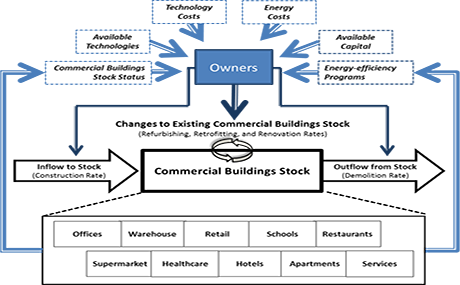
Energy Systems and Infrastructure Analysis
Commercial Building Agent-based Model
Developing, testing, and validating an agent-based model of the commercial building market for studying the adoption and impact of new technologies on energy use in collections of buildings

Understanding and modeling the adoption of energy efficient technology is a topic of interest to a great many groups, including government policy makers, utility incentive program designers, and industry manufacturers. Such modeling is usually done in a top-down approach where technology adoption is assumed to follow a standardized diffusion curve.
The Argonne Commercial Building Agent-based Model (CoBAM) is a tool designed to estimate the adoption of energy efficient building technologies using a bottom-up approach. The agent-based system models the behaviors, interactions, and decision logic of building owners considering the adoption of energy efficient technologies. The system considers the events that trigger consideration (equipment failure, equipment aging, high energy bills, yearly analysis of sustainability, sale of building or end of lease, decision to do major renovation, etc.) and then models a wide variety of different types of owners (government, private owner occupied, private owner who leases) with differing risk profiles (aggressive, passive, risk averse) and focus goals (economics, energy reduction, best performance, etc.). Decision patterns can be modified by policy decisions (required energy targets, building code, etc.), incentive programs (rebates, financing, etc.), and information availability (advertising, word of mouth, social media, etc.). CoBAM uses building energy models to understand the energy and cost savings of different technologies and uses that as part of the input into the decision process. At the same time those data can be used for studying the energy use of buildings on a large scale.
Using CoBAM, policy makers can understand the impact of different policy decisions on energy use and carbon emission in differing regions. R&D Strategic planners can use CoBAM to understand which technologies should be targeted for research, development, and deployment investment. Utilities can use CoBAM to design more effective incentive programs and better target customers. Industry can use CoBAM to predict the adoption of new technologies and understand the impacts of information and marketing campaigns.